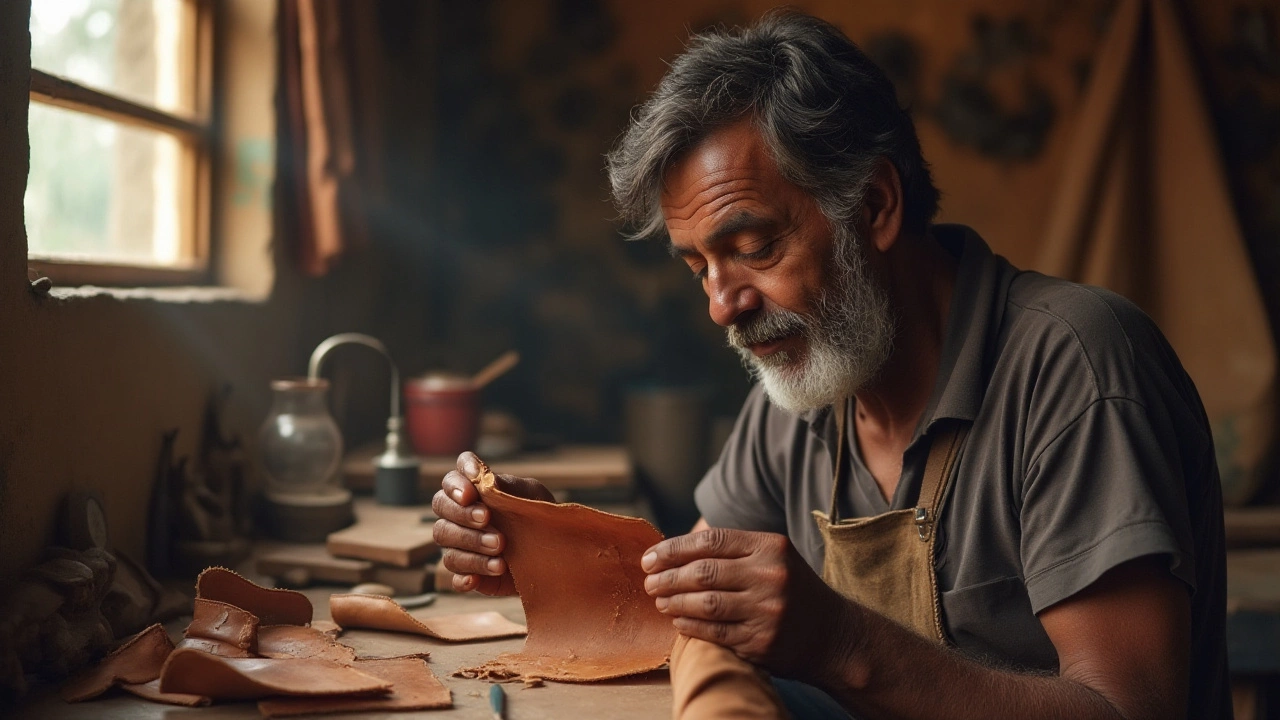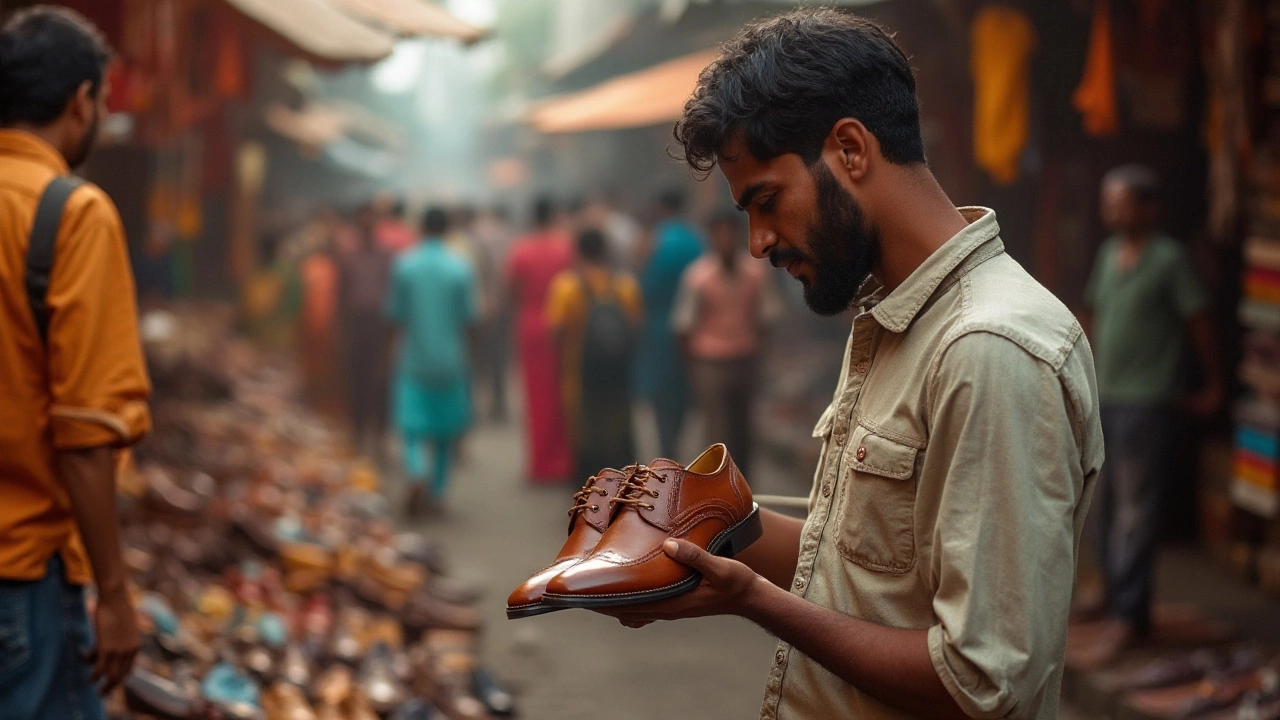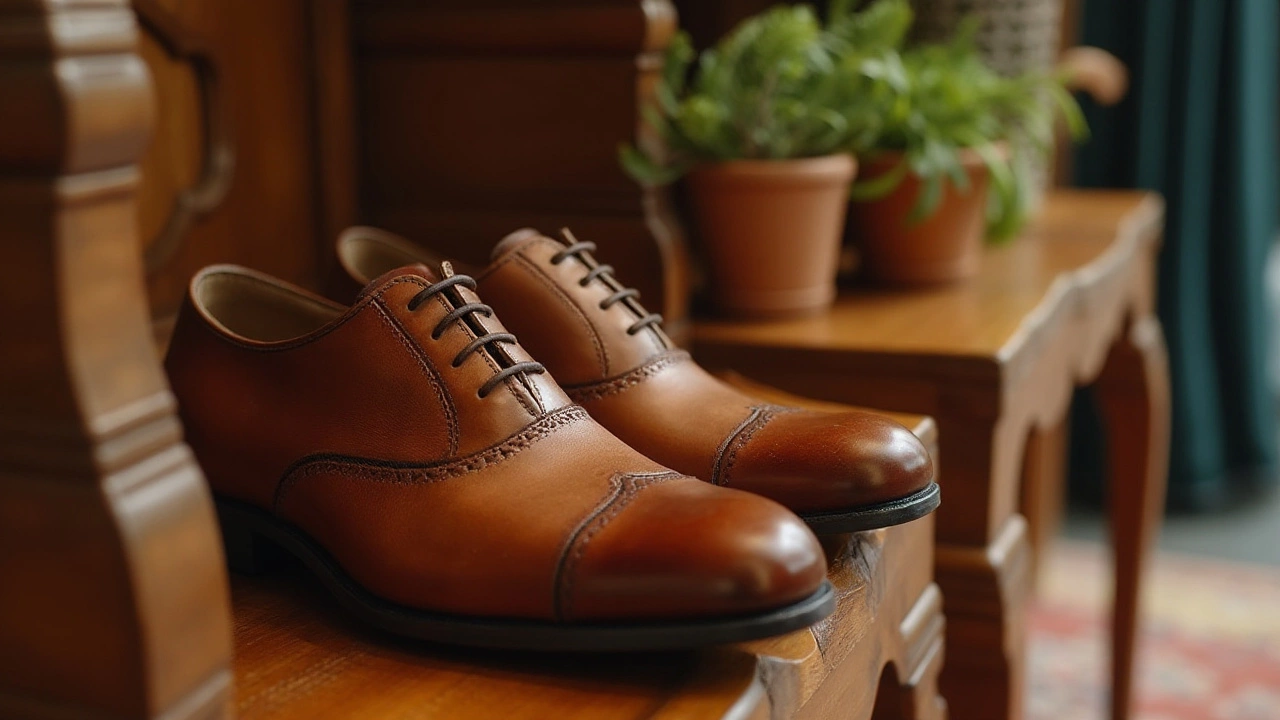Identifying High-Quality Leather Shoes: A Comprehensive Guide

When you buy leather shoes, it's exciting to imagine the adventures you'll have in them, but choosing the right pair is crucial. If you're investing in leather, you want shoes that not only look good but last long. How do you discern a cut above the rest amid the myriad options? It's all about understanding quality.
High-quality leather shoes are more than a luxury—they're a testament to skillful craftsmanship and attention to detail. Recognizing these traits requires a keen eye and some insider knowledge. As we wander through the nuances of leather grains, impeccable stitching, and resilient soles, you'll unlock the secrets to identifying footwear that's worth every penny.
Join me as we walk through the essential checkpoints to consider before your next leather shoe purchase. Equip yourself with the expertise to recognize both craftsmanship and care, and make informed choices that reflect your style and sophistication.
- Understanding Leather Types
- Inspecting the Leather Grain
- Craftsmanship and Stitching
- Sole Material and Construction
- Care and Longevity Tips
Understanding Leather Types
When embarking on the journey of purchasing leather shoes, grasping the different types of leather is your first step toward distinguishing quality. Leather is the skin of an animal, often processed to become more durable and suitable for a variety of uses. There are several types of leather, each defined by its finish and the part of the hide it is prepared from. Full-grain leather is one of the highest quality options available. This leather maintains the hide's natural surface, and consequently, it is incredibly tough, breathable, and develops a beautiful patina over time. The distinctiveness of each pair of shoes crafted from such leather marks a story unique to the wearer. Moving down the spectrum, we encounter top-grain leather. Though it is slightly less robust as it goes through a sanding and buffing process to remove imperfections, it offers a sleek appearance and remains a popular choice for quality footwear.
Beneath the surface of high-end options lies genuine leather. Its name can be misleading, as it simply means any leather product that is not top- or full-grain. Genuine leather is often assembled from leftover pieces of hide and treated to mimic higher quality types. It's often less durable but offers an economical alternative for those on a budget. Then there is corrected-grain leather, which has undergone substantial treatments, including sanding and embossing, to imitate a more uniform appearance. This processing makes it more affordable but at the cost of reduced longevity. It’s crucial to know these variations since they directly affect how quality leather shoes perform and age.
"The type of leather you choose determines not just appearance, but how the shoe molds to your foot and stands the test of time," says renowned leather expert John Smithson.
Specialty leathers also contribute to the broad palette of materials. Patent leather, recognized for its high-gloss finish, is achieved through a coating process. While visually striking, it lacks the maturity of a patina seen in other leathers. Nubuck, made from the outer layer of calfskin or cowhide, is sanded to offer a velvety texture. However, its plush surface demands careful maintenance to avoid staining. On the other hand, suede, also a soft-grain leather, is crafted from the underside of the hide. Its aesthetic appeal is undeniable, yet it necessitates a gentle touch and protective measures against the elements. Identifying the characteristics of these leather types will equip you with the knowledge to navigate the shoe store wisely, ensuring that your investment is sound and your choice enduring.
Inspecting the Leather Grain
Understanding the leather grain is one of the cornerstone skills in recognizing high-quality leather shoes. Leather grain refers to the natural texture, pattern, and surface of the leather that you can see and feel. Two primary grains are often discussed: full-grain and top-grain.
Full-Grain Leather: The Pinnacle of Quality
Full-grain leather is considered the best type because it maintains the complete grain of the hide. This grain hasn't been altered, which means it retains its natural strength and resilience. The unembellished surface of full-grain reveals scrapes and stretch marks acquired during the animal's life, adding unique character to each pair of shoes. It's important to know that full-grain is the strongest and most durable leather available.
"Full-grain leathers are as close to perfection as it gets," explains renowned Italian shoemaker, Alessandro Zanetti. "Their integrity and ability to age beautifully make them a top choice for craftsmen like myself."As full-grain leather ages, it develops a rich patina, a sheen produced over time from the oils of the feet and regular use. A good pair of full-grain leather shoes not only withstands rigorous activity but becomes more aesthetically pleasing over years of wear.
Top-Grain Leather: The Polished Alternative
Top-grain leather takes the second spot when it comes to quality. It is slightly altered with a sanding process to remove imperfections. This results in a more uniform finish that many find appealing. Although this sanding process slightly reduces the durability, it offers a cleaner and more polished look. Top-grain is more resistant to stains than full-grain, making it a popular choice for those who prefer a more pristine appearance.
If you are unsure of a shoe's leather grain, a handy trick is to look for small, perfectly imperfect details. Natural grain leather should not feel like plastic under your fingers; instead, it should have a subtle, textured feel. A magnifying glass might reveal fine details like pores and irregularities, clues that point toward true quality. Tempting as it may be to choose a flawless, smooth shoe, visible grain often indicates better quality.
A few brands go as far as to improve the functionality of their full-grain leathers with treatments, enhancing water resistance without compromising the natural feel. Keep an eye out for such offerings if you're seeking a balance between style and practicality. There's an added satisfaction in knowing your leather shoes will conquer different seasons, keeping you stylish and comfortable.
| Type | Characteristics | Maintenance |
|---|---|---|
| Full-Grain | Unaltered surface, retains scars | Requires regular conditioning |
| Top-Grain | Slightly sanded, polished finish | Easy to clean, less frequent conditioning |

Craftsmanship and Stitching
In the realm of beautiful leather shoes, the devil is often in the details. While aesthetics play a big role, the true value of a leather shoe is often revealed in its craftsmanship and stitching. This is where you’ll discern if you’ve got a shoe bound to endure over many seasons, both in style and structure. The meticulous attention to detail in the shoe-making process is what distinguishes a mere accessory from an investment piece. When assessing shoe craftsmanship, consider the precision of stitches, consistency in pattern, and how these elements contribute to the shoe’s fit and finish.
Stitching is not just about holding pieces together; it’s an art form that speaks of the shoemaker's dedication and care. High-quality leather shoes typically feature hand-stitched welts. This traditional method, often referred to as a Goodyear welt, involves stitching a leather strip around the edge of the shoe, which increases durability and water resistance. Since it allows replacement of the sole without damaging the upper, this technique is prized among connoisseurs for extending the life of the shoe. Machine stitching might be faster, but hand stitching holds a place of reverence for its strength and the unique character it lends to each pair.
When inspecting the stitching, notice the thread’s weight and color — they should complement yet stand apart from the leather. Look for uniform spacing, even tension and knots that aren’t visible. Uneven stitches might indicate hurried production and could lead to tears or looseness as you wear them. Most premium brands pay attention to these aspects to maintain a reputation for excellence. As Maximilian Schilling, a seasoned cobbler, once said,
"A shoe’s seams foretell its journeys."This wisdom should guide you as you pore over potential purchases, ensuring your footwear will join you on many escapades.
If you’re comparing different pairs, you may also find it beneficial to slightly flex the shoe. The leather near the stitches should bend with ease, indicating high-quality material. Rigid leather may suggest synthetics have been mixed in, compromising the shoe’s longevity. A comprehensive understanding of craftsmanship allows for smart choices and investments in footware with time-tested endurance and elegance. Always remember, while styles may change, the quality of craftsmanship is timeless, and exceptional stitching serves as a beacon of a shoe’s promise for enduring wear.
Sole Material and Construction
The sole of a shoe is often its unsung hero, performing the critical job of not only protecting your feet from the ground beneath but also taking your every step in stride with grace and resilience. To properly judge the quality of leather shoes, focusing on the sole is as important as examining the leather itself. A high-quality sole ensures durability, comfort, and a proper grip, making it a crucial component of any shoe. Leather soles, known for their classic appeal and sophistication, remain a favorite among traditional shoemakers. They offer a unique adaptability, molding to the shape of your foot over time, allowing for a bespoke fit. In contrast, rubber soles, recognized for their resilience and practicality, bring modern durability to the equation for those who tread diverse terrains. A combination of leather uppers with rubber soles, often seen in contemporary styles, offers the perfect compromise between elegance and practicality. No matter your preference, a thorough understanding of sole material helps guide a discerning purchase.
The construction of the sole is equally significant. Understanding the various methods can illuminate the artistry and functionality behind each pair of shoes. The renowned Goodyear welt is considered the gold standard for men's dress shoes, offering a refined blend of durability and traditional craftsmanship. This intricate process involves stitching a welt to both the insole and outsole, forming a sturdy and repairable bond. A successful review in The Journal of Footwear Craftsmanship once noted, "A Goodyear-welted sole is like a promise—a promise of endurance and an assurance of longevity." Rubber cement soles, more prevalent in casual footwear, emphasize flexibility and water resistance, catering to the contemporary lifestyle demands.
Moreover, the thickness and design of the sole can transform the comfort and style of the shoe significantly. Thicker soles often signal increased comfort, offering better cushioning and support, especially beneficial for longer durations on your feet. Styles like the Creeper or Platform rely heavily on their distinct sole silhouettes for aesthetic and functional appeal. An engaging statistic derived from the International Footwear Manufacturing Federation points out that a well-constructed sole can enhance a shoe's lifespan by up to 80%, reinforcing the importance of sole quality. Lastly, when considering the heel, attention should be given to its attachment. A well-designed heel not only elevates the shoe's style quotient but also absorbs shock, providing better stability and control. Ensuring a snug heel fit is necessary to prevent any slippage or discomfort during wear. Hence, understanding both the material and method of construction helps decipher the leather shoe's true quality, guiding you towards a choice that perfectly balances style with substance.

Care and Longevity Tips
Caring for your leather shoes is key to ensuring they stand the test of time and accompany you on countless journeys. Too often, folks neglect regular maintenance, leading to cracked leather, worn soles, and a dull appearance. To keep your beloved footwear looking their best, start with proper cleaning. Dirt and debris can accumulate over time, so wipe your shoes down with a slightly damp cloth after each wear. It's a small step that prevents wear. For a deeper clean, use a leather soap or cleaner that is specifically formulated for quality leather shoes. Avoid harsh detergents as they can strip natural oils, causing the leather to dry out and become brittle.
Once cleaned, conditioning your shoes is equally important. Leather is skin, after all, and needs hydration to keep it supple and pliable. Invest in a quality leather conditioner and apply it regularly. A monthly application works well for most shoes, but consider bi-weekly care if they are exposed to harsh conditions. Conditioning not only softens the leather but also acts as a protective barrier against moisture and stains. When applying, use a clean cloth and work in circular motions to ensure an even distribution. Allow the conditioner to absorb overnight before buffing it with a leather brush to bring out the shine.
Polishing is the next step, not just for aesthetics but also for protection. A good polish creates a seal that can prevent water penetration and scuffs. Choose a polish in the same shade as your shoes or a neutral one for an understated sheen. Before applying, ensure that your shoes are clean and dry. Using a soft cloth, apply a small amount of polish in circular motions, covering the entire surface. Let it dry for several minutes and then buff with a brush for that high-gloss finish. Don’t overlook the edges of the soles, which can also benefit from a coat of polish to avoid unsightly darkening.
Another aspect of maintaining high-quality leather shoes is proper storage. Keep them in a cool, dry place, away from direct sunlight that can cause fading and heat that can warp the leather. Stuff your shoes with newspaper or use shoe trees to help retain their shape. Shoe trees, preferably cedar ones, can also absorb moisture and odors, keeping your shoes fresh. Rotating your footwear is also crucial—give each pair some downtime to rest and recover from wear.
"Always invest in quality shoe care products. Think of them as skincare for your shoes," says renowned shoe designer Paul Smith.
Lastly, don't forget about the soles. Regularly check the condition of both the outer and inner soles. If you notice excessive wear or discomfort, it may be time to resole them. Taking your shoes to a professional cobbler for this can extend their life significantly. They can also replace or repair heels, giving your shoes a new lease on life. While it might seem like a costly endeavor, it's often much cheaper than buying a new pair. Plus, it helps preserve that perfect fit you've broken in over time.